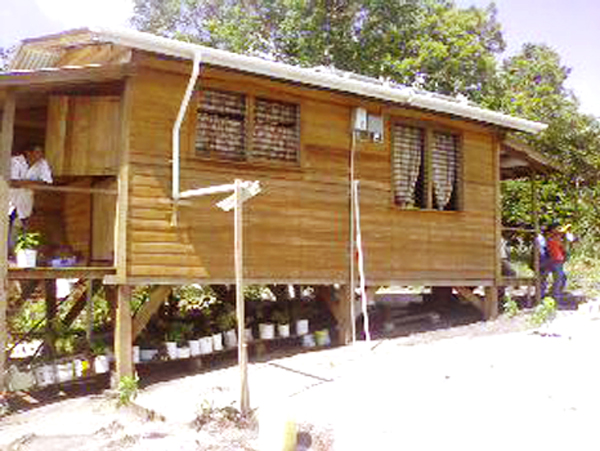—pump driven by solar power
It took around 30 years for the residents in Kuru Kuru to experience the thrill of running water through a tap, but after an investment of $8.3M in a Solar Water System by the Rotary Club of Georgetown, the community and others this is now a reality.

According to information provided by the Rotary Club, the Kuru Kuru Water Project was designed to provide a source of water in the dry season so the population of some 300 would not have to transport water from the creek, a kilometer or more away. Its novel feature is that the system is solar powered.
President of the Rotary Club of Georgetown Aubrey Roberts in his address at the launching of the project said, “The Kuru Kuru village had several residential lots but only 70 households mainly due to the lack of a water distribution infrastructure readily accessible to the homes.” He explained that there were two creeks and a hand-pump that had been used by the community in the dry season, and rainwater harvesting was also practised by residents, although this was limited by the storage facility of the household. Food for the Poor had provided the community with a hand-pump several years ago, but it no longer works.
In a project overview, it was noted that Rotrary International had recognized there was a global demand for water in unserved communities around the world in 2004, and had challenged Rotary clubs to develop and implement water supply projects for deserving commuities.
Roberts told his audience: “Our club first conceptualized this project in September 2004 in collaboration with the New Highway Producers Co-op Society (NHPCS).
“This water system has a very low operating cost since it uses the abundant sunlight to produce the energy to power the variable speed motor that drives the water pump,” he explained, adding that it also used no batteries. As a consequence the pump works in the daytime only and the water is stored in 900 litre elevated storage tanks. This makes possible 24/7 access to water at 14 locations in the community, benefiting around 200 persons. The pump delivers a maximum flow of 45 litres per minute.
Attending the launching were Canadian High Commissioner Charles Court, Amerindian Affairs Minister Pauline Sukhai (touted as one of the initiators of the project prior to her current ministerial appointment) along with community members and noted Rotarians like Stanley Ming. (Ming also pledged to assist the community with books for its library and offered to assist in setting one up if they did not have one.)
This project had several objectives, including to abstract and chlorinate 7200 gallons of water daily for drinking, cooking and bathing; to utilise alternative energy (solar energy) 12 hours per day for pumping the water; to install four hours (2000 gallons) of elevated storage and to construct a distribution pipe for serving twenty standpipes around the community.
The original estimate and proposal were circulated to the NHPCS and some Rotary Clubs in the US. Contributions came from the Rotary Clubs of Scottsville and Red Jacket – Rotary District 7120 and the Rotary District 7730 both of the US,
In addition the Rotary Foundation (TRF) made a grant matching the sum raised by the clubs, and remitted to the Rotary Club of Georgetown US$24,600 in February 2007.
Roberts said that their first challenge had been the increased project cost as a result of the introduction of the Value Added Tax. In August 2007, the construction of the storage and distribution systems began but the well-drilling and development took several months “and caused much anxiety to us all,” said Roberts, since the rehabilitation of an existing well had to stop because it was shallow and would not have supported the expanded system. The NHPCS then decided to finance the drilling of the new well with the support of the Rotary Club of Georgetown.
“We must, however, care and protect the system from vandalism and most importantly wastage.You must be constantly looking for leaks and report same,” Roberts told the residents.
Audreyanna Thomas, National Coordinator of the Water Supply and Sanitation Council (WSSCC) based in Geneva, Switzerland which is hosted and administered by the World Health Organization (WHO) noted that 1.1 billion or about 20% of the world’s population lacked access to safe water and 2.6 billion or about 40%, did not have access to adequate sanitation. A piped-water system in any community was one of the significant pillars of development.
“It means that women and children will spend less time collecting or fetching water. So that women could use the same time they were fetching water for income and development ventures and for spending more time with their children and family,” she said.
Improved access to water could automatically lead to improved sanitation and hygiene and generally improved health, said Thomas, who added that diarrhoea and other water related diseases in the community would be reduced.
Rotarian Kit Nascimento described the water project as “very unique,’ in that solar power was being used to power the well.
A 30-year resident, Pearl Bobb, referred to how the community had suffered for water, but that now “I see we can drink water from the pipe.”

